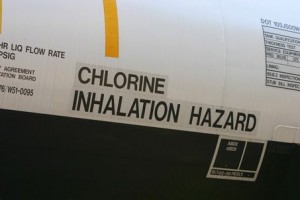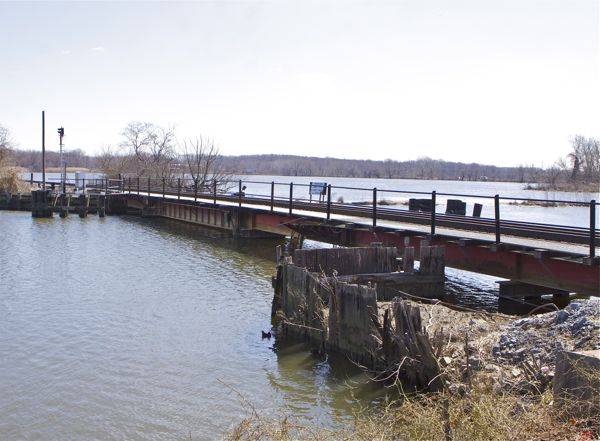How many old, defective, poorly maintained railroad bridges are there in NJ?
How many more toxic train derailments are waiting to happen?
Railroad Safety Left in hands of Railroad Under Federal law
State Railroad Planning Reflects a Narrow Set of Priorities
This post began as a brief note on the NJ Department of Transportation (DOT) update of the State Rail Plan with respect to the “Rail Freight Assistance Program”, in the context of the recent Paulsboro Toxic Train derailment.

chlorine gas is deadly (unsecured rail tanker car sits on track in Rapano, north of Paulsboro, just feet from daycare center and many homes
Because I am no transportation or railroad expert, I had to do a little basic research as background. In doing that, I uncovered some stunning information on railroad safety, which greatly expanded the scope of the idea for my original post.
So, read on, but bear with me as I bounce around this can of worms from federal safety regulation to state transportation planning and capital budgeting – keeping in mind the distinction between roadway bridges and railroad bridges.
Last month, I was disappointed but not surprised to read a NJ Spotlight story, based on US DOT National Bridge Inventory data, that reported that more than 200, or 25%, of NJ’s roadway bridges are obsolete or structurally deficient.
I say not surprised, because prior Reports by the American Society of Civil Engineers suggest the problem is far larger in magnitude. According to the ASCE 2013 assessment, NJ’s roadway bridges are far worse off:
BRIDGES
- 651 of the 6,554 bridges in New Jersey (9.9%) are considered structurally deficient.
- 1,717 of the 6,554 bridges in New Jersey (26.2%) are considered functionally obsolete.
But these reports focus on roadway bridges – what’s the state of our railroad bridges? Where could I find that data on railroads?
According to the ASCE report,“New Jersey has 18 freight railroads covering 983 miles across the state, ranking it 40th by mileage.“, but there was nothing reported about the number of or condition of railroad bridges.
A quick Google revealed that – holy shit! – according to the Federal Railroad Administration (FRA), railroad bridge safety is left up to the railroads! FRA said:
The Railroad Safety Improvement Act of 2008 mandates that all track owners inspect their railroad bridges at least once per calendar year. Prior to the passage of this legislation, railroad bridge inspections were highly encouraged, but not mandatory. The new statute requires track owners to conduct and then submit risk management reports to the Federal Railroad Administration (FRA). In addition, track owners are required to document their yearly inspections and are also subject to random audits. Owners of structurally deficient railroad bridges can be levied fines of up to $100,000 and information on deficient railroad bridges will be published in the federal registry.
Citizens concerned about the state of railroad bridges in their communities are encouraged to contact the owner of the bridge first. However, the FRA is always available to concerned citizens and can be contacted via email at: RRSWebInquiries@dot.gov
Imagine that – citizens can contact the railroads with safety concerns, or shoot the FRA an email!
And I thought environmental oversight and safety were lax!
[Note: I will write in the future about a recent NJ DOT Report on railroad infrastructure vulnerability to climate change, but that is beyond the scope of this post).
So, getting back to the original topic of this post – after reading that NJ Spotlight story, in the wake of last year’s Paulsboro Toxic Train derailment, I was curious about how many NJ railroad bridges were similarly obsolete or structurally deficient, and what the funding deficit was to repair or replace those bridges.

Paulsboro swing bridge, scene of the crime. Rail bridge over 100 years old - millions of pounds of toxic chemicals regularly cross thie bridge.
So, in light of the fact that the feds leave rail safety up to the private railroads, I was curious about how NJ State programs address this set of issues.
Recall that the Paulsboro toxic train derailment raised not only serious public health, environmental, and safety concerns.
Because the rail line was shut down for so long, there were huge negative economic dislocations, including a strategic threat to the continued existence of the chemcial industry in NJ, a major NJ employer and economic player.
According to the Philadelphia Inquirer, the chemical industry was unable to ship product and threatened to relocate several hundred jobs and shift production to other states if the railroad line were not reopened (see also: Chemical Blackmail In Toxic Train Wreck).
So, I read with interest a recent relevant NJ DOT Report: STATE FISCAL YEAR 2013 UPDATE REPORT OF THE NEW JERSEY STATE RAIL PLAN:
The New Jersey State Rail Plan is one component of a wide range of activities undertaken by the New Jersey Department of Transportation to advance the following freight movement goals:
- Integrated Planning: To foster increased cooperation and coordination among public agencies and between public agencies and the private sector.
- Economic Development: To retain and generate jobs, maintain and increase revenue, and help maintain and enhance the state’s competitive position through strategic freight initiatives.
- Mobility: To improve access to the national freight system and improve the efficiency of goods movement.
- Sustainable Investment:To cultivate and protect freight initiatives which provide lasting returns on public investment.
- Community and Environment: To promote freight as a good neighbor and the movement of freight in a socially and environmentally responsible manner.
- Safety and Security: To protect people, cargo, and infrastructure.
The Rail Plan includes consideration of “safety” and the “environment” – so, does that Plan include consideration of risks resulting from hazardous chemical cargo shipments across ancient and deficient bridges?
Short answer – no.
The July 2013 Update shows that over the last 6 years, NJ DOT’s “Rail Freight Assitance Program” identified $159 million in “candidate projects”, averaging about $25 million per year, including PRIVATE railroad assistance.
How much of this need was met? How much money went to repair or replace dangerous railroad bridges? Was there eligible candidate funding identified for the notorious Paulsboro swing bridge, built back in 1873?
The actual FY’14 DOT Capital budget, funded just $10 million of this identified need and THIS NEED DID NOT SPECIFICALLY ADDRESS CHEMICAL RAIL SAFETY.
I word searched the DOT Plan Update and Capital Budget for “Paulsboro” and was shocked by what I found.
Funding need was identified for almost $1 million for Paulsboro refinery improvements. And there was $1 million actually budgeted in FY’13 for the “Rt. 295 – Paulsboro Brownfields Access” project
But, I noticed that there was but no funding provided to repair or replace the notorious Paulsboro swing bridge over the Mantua Creek, which caused the “Toxic Train” derailment last November that forced evacuation of the community and hospitalized almost 100 people.
That bridge is privately owned by a profitable railroad, so it makes sense not to provide public funding. But, the safety of that bridge is a major issue that should be addressed in transportation plans. I could not find that analysis.
So it looks like neither federal or state trasportation agencies are looking at railroad bridge safety, a huge risk in a state like NJ, where people live so close to rail and so much chemical cargo is shipped on ancient rail lines over ancient bridges.
Last year’s Paulsboro derailment has been followed by a series of high profile rail accidents, including last months Baltimore train derailment which involved hazardous chemicals and caused a major explosion and fire
According to a lawsuit filed by local police and emergency responders, that bridge is over 140 years old and had failed scores of insepctection reports and received numerous violations:
The bridge in question had a significant history of failure. A similar derailment and collapse occurred in the same place on August 23, 2009. Even after purported repairs to the bridge, nearby residents reported to Defendants that they heard strnge noises coming from the bridge, including a loud “bang” when no train was on it. […]
During the year leading to November 30, 2012, the defendant received at least 23 “trouble tickets” reporting that the Paulboro Gridge had malfunctioned. […]
Since October 27, 2012, approximately one month before this accident, the defendants received at least nine such “trouble tickets” reporting improper operation of malfunction of the bridge in question.
The bridge was allowed to reopen to more hazardous chemical cargo shipments without being repaired or replaced, and before a NTSB accident investigation is completed.
Immediately after the accident, NJ Senator President Sweeney and recently passed US Senator Lautenberg have vowed to have the bridge repaired or replaced.Lautenberg had introduced federal legislation in 2011 to upgrade rail safety, but his bill went nowhere.
In March, I was relieved to read that the south Jersey Courier-Post reported Damaged Paulsboro bridge will be replaced
The railroad bridge damaged during a train derailment and chemical spill Nov. 30 in Paulsboro will be replaced.
A new swing bridge over Mantua Creek is expected to be operational by September 2014, according to a spokesman for the bridge’s owner, Conrail. In the meantime, the current span will remain in use but the waterway that passes underneath will remain inaccessible to boaters until construction is complete.
But, despite numerous failed inspections and violations, the bridge didn’t seem to be on anyone’s radar screen, including the NJ DOT’s Rail Freight Assistance Program.
How many other old, defective, poorly maintained railroad bridges are there in NJ? How many more toxic train derailments are waiting to happen?
Like I said, I am no transportation expert.
But someone needs to explain the planning justification for identifying the need for private railroad projects as candidates for state funding, while ignoring 125 year old bridges that have caused serious accidents, all while hazardous cargo continues to be shipped through hundreds of NJ communities, putting the safety of millions of NJ residents at risk.


Pingback: adoption private investigators new york
Pingback: WolfeNotes.com » National Safety Board Report on Paulsboro Toxic Train Derailment Provides Devastating Criticism Of NJ’s Oversight of Chemical Safety
Pingback: Quantum Vision System Review
Pingback: fitflop Chaussures
Pingback: ray ban solbriller
Pingback: wyroby szklane piotrków trybunalski